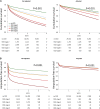CKD and Acute and Long-Term Outcome of Patients with Peripheral Artery Disease and Critical Limb Ischemia
- PMID: 26668023
- PMCID: PMC4741036
- DOI: 10.2215/CJN.05600515
CKD and Acute and Long-Term Outcome of Patients with Peripheral Artery Disease and Critical Limb Ischemia
Abstract
Background and objectives: Despite the many studies showing an association between CKD and a high risk of ischemic events and mortality, the association of CKD with peripheral arterial disease (PAD) still has not been well described.
Design, setting, participants, & measurements: This large cohort study assessed the association of CKD, even in the earlier stages, with morbidity, short- and long-term outcome, and costs among patients with PAD.
Results: We identified 41,882 patients with PAD who had an index hospitalization between January 1, 2009, and December 31, 2011. Of these, 8470 (20.2%) also had CKD (CKD stage 2: n=2158 [26%]; stage 3: n=3941 [47%]; stage 4: n=935 [11%]; stage 5: n=1436 [17%]). The ratio of women to men was 1:1.2. Compared with patients without known CKD, those with CKD had higher frequencies of coronary artery disease (1.8-fold higher; P<0.001), chronic heart failure (3.3-fold higher; P<0.001), and Rutherford PAD categories 5 and 6 (1.8-fold higher; P<0.001); underwent significantly fewer revascularizations (0.9-fold fewer; P<0.001); had a nearly two-fold higher amputation rate (P<0.001); had higher frequencies of in-hospital infections (2.1-fold higher; P<0.001), acute renal failure (2.8-fold higher; P<0.001), and sepsis (1.9-fold higher; P<0.001); had a 2.5-fold higher frequency of myocardial infarction (P<0.001); and had a nearly three-fold higher in-hospital mortality rate (P<0.001). In an adjusted multivariable Cox regression model, CKD remained a significant predictor of long-term outcome of patients with PAD during follow-up for up to 4 years (until December 31, 2012; median, 775 days; 25th-75th percentiles, 469-1120 days); the hazard ratio was 2.59 (95% confidence interval, 2.21 to 2.78; P<0.001). The projected mortality rates after 4 years were 27% in patients without known CKD and 46%, 52%, 72%, and 78% in those with CKD stages 2, 3, 4, and 5, respectively. Lengths of hospital stay and reimbursement costs were on average nearly 1.4-fold higher (P<0.001) in patients who also had CKD.
Conclusions: This analysis illustrates the significant and important association of CKD with in-hospital and long-term mortality, morbidity, amputation rates, duration and costs of hospitalization, in-hospital treatment, and complications in patients with PAD.
Keywords: acute kidney injury; amputation; chronic kidney disease; cohort studies; hospital mortality; hospitalization; humans; length of stay; outcome; peripheral arterial disease.
Copyright © 2016 by the American Society of Nephrology.
Figures

Similar articles
-
Association of CKD with Outcomes Among Patients Undergoing Transcatheter Aortic Valve Implantation.Clin J Am Soc Nephrol. 2017 May 8;12(5):718-726. doi: 10.2215/CJN.10471016. Epub 2017 Mar 13. Clin J Am Soc Nephrol. 2017. PMID: 28289067 Free PMC article.
-
Acute and chronic anemia and short- and long-term outcome of patients with peripheral arterial disease and critical limb ischemia.Eur J Intern Med. 2016 Jun;31:62-7. doi: 10.1016/j.ejim.2016.03.002. Epub 2016 Mar 22. Eur J Intern Med. 2016. PMID: 27021473
-
Long-Term Outcome of Lower Extremity Bypass Surgery in Patients with Chronic Kidney Disease and Critical Limb Ischemia in Germany.Ann Vasc Surg. 2024 Nov;108:365-374. doi: 10.1016/j.avsg.2024.06.014. Epub 2024 Jul 14. Ann Vasc Surg. 2024. PMID: 39009125
-
Literature review and meta-analysis of the efficacy of cilostazol on limb salvage rates after infrainguinal endovascular and open revascularization.J Vasc Surg. 2021 Feb;73(2):711-721.e3. doi: 10.1016/j.jvs.2020.08.125. Epub 2020 Sep 4. J Vasc Surg. 2021. PMID: 32891809 Free PMC article.
-
Impact of Kidney Disease on Peripheral Arterial Interventions: A Systematic Review and Meta-Analysis.Am J Nephrol. 2020;51(7):527-533. doi: 10.1159/000508575. Epub 2020 Jun 22. Am J Nephrol. 2020. PMID: 32570255
Cited by
-
Alprostadil treatment of critical limb ischemia in hemodialysis patients : A retrospective single-center analysis.Wien Klin Wochenschr. 2019 May;131(9-10):209-215. doi: 10.1007/s00508-018-1407-z. Epub 2018 Nov 12. Wien Klin Wochenschr. 2019. PMID: 30421286 Free PMC article.
-
The Impact of Chronic Kidney Disease on Mid-Term Outcomes after Revascularisation of Peripheral Arterial Occlusive Disease: Results from a Prospective Cohort Study.J Clin Med. 2022 Aug 14;11(16):4750. doi: 10.3390/jcm11164750. J Clin Med. 2022. PMID: 36012989 Free PMC article.
-
The burden of critical limb ischemia: a review of recent literature.Vasc Health Risk Manag. 2019 Jul 1;15:187-208. doi: 10.2147/VHRM.S209241. eCollection 2019. Vasc Health Risk Manag. 2019. PMID: 31308682 Free PMC article. Review.
-
Corrected QT Interval and Outcomes of Dialysis Patients with Symptomatic Peripheral Artery Disease: A Prospective Cohort Study.J Clin Med. 2024 Jan 23;13(3):654. doi: 10.3390/jcm13030654. J Clin Med. 2024. PMID: 38337348 Free PMC article.
-
One year clinical outcomes of Rutherford 6 chronic limb threatening ischemia patients undergoing lower limb endovascular revascularisation from Singapore.CVIR Endovasc. 2022 Jul 6;5(1):32. doi: 10.1186/s42155-022-00306-1. CVIR Endovasc. 2022. PMID: 35792985 Free PMC article.
References
-
- Hirsch AT, Duval S: The global pandemic of peripheral artery disease. Lancet 382: 1312–1314, 2013 - PubMed
-
- Garimella PS, Hart PD, O’Hare A, DeLoach S, Herzog CA, Hirsch AT: Peripheral artery disease and CKD: A focus on peripheral artery disease as a critical component of CKD care. Am J Kidney Dis 60: 641–654, 2012 - PubMed
-
- Drey N, Roderick P, Mullee M, Rogerson M: A population-based study of the incidence and outcomes of diagnosed chronic kidney disease. Am J Kidney Dis 42: 677–684, 2003 - PubMed
-
- Meyer A, Bunzemeier H, Hausberg M, Walter M, Roeder N, Breithardt G, Reinecke H: Impact of different stages of chronic kidney disease on in-hospital costs in patients with coronary heart disease. Nephrol Dial Transplant 23: 1955–1960, 2008 - PubMed
-
- Levey AS, Atkins R, Coresh J, Cohen EP, Collins AJ, Eckardt KU, Nahas ME, Jaber BL, Jadoul M, Levin A, Powe NR, Rossert J, Wheeler DC, Lameire N, Eknoyan G: Chronic kidney disease as a global public health problem: Approaches and initiatives - a position statement from Kidney Disease Improving Global Outcomes. Kidney Int 72: 247–259, 2007 - PubMed
Publication types
MeSH terms
LinkOut - more resources
Full Text Sources
Medical

